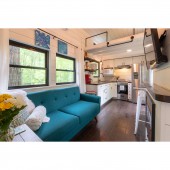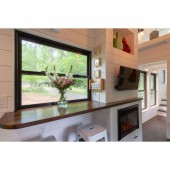The Luminaire Tiny House on Wheels by Erin Adams |
Home > Winners > #76738 |
 |
|
||||
| DESIGN DETAILS | |||||
| DESIGN NAME: The Luminaire PRIMARY FUNCTION: Tiny House on Wheels INSPIRATION: The Luminaire was inspired by my desire to live a more sustainable and simplified lifestyle. This micro-dwelling allowed me to reduce my carbon footprint, source local and recycled materials, improve indoor air quality, avoid marring the mountain landscape, be mobile and simplify my life. Custom designed for full-time living, it offers many functional aspects and luxurious amenities that are not found in most tiny homes on the market today. I wanted to show that downsizing did not equate to downgrading. UNIQUE PROPERTIES / PROJECT DESCRIPTION: The Luminaire is a tiny home on wheels, designed with function and sustainability in mind. With an interior width of 7.5 feet and length of 27 feet, this micro-dwelling is designed for full-time living. Unlike most wheeled tiny homes, The Luminaire offers the amenities of traditional homes, with a full kitchen, standard sofa, fireplace, full- size bathtub, 7 foot closet, dressing vanity area, standing height in the master, full-size washer and dryer, guest sleeping loft, dining area & 14 windows OPERATION / FLOW / INTERACTION: Unlike many tiny homes on the market today, the Luminaire requires no transformation to access the various desired functions of the space. Research indicates many designs requiring laborious maneuvers to make living spaces function in multiple ways. Examples include a bed that has to be stowed each time you want to utilize the home office or a sofa has to be rearranged to create a dining space. The goal of the Luminaire’s layout was to not require these transformative items, thus allowing for use of all functions simultaneously and with no additional manual labor required. PROJECT DURATION AND LOCATION: The research for this project began in May of 2016, with design drawings finalized in May of 2017 and the construction completed in June of 2018. The Luminaire was designed and built in Sylva, NC and was exhibited in June of 2018 at Jackson County Arts Council's Mobile Art Showcase and exhibited at Western Carolina University's Fine Art Museum in January through May of 2019. FITS BEST INTO CATEGORY: Social Design |
PRODUCTION / REALIZATION TECHNOLOGY: With the goal of living more sustainably in a functional space for a middle-aged person, the process began with extensive research on existing tiny homes currently on the market. It became apparent that most layouts included primary sleeping lofts accessed by steep ladders with little headroom in bed, no area to stand up while dressing and lacked amenities typically enjoyed in traditional housing. Research indicated a need for a layout that was suitable for full-time, adult living, while reducing my carbon footprint and not giving up the amenities found in traditional housing. SPECIFICATIONS / TECHNICAL PROPERTIES: The Luminaire is road legal, with exterior length of 8.53m, width of 2.59m and 4.11m from the road in height. Built on a custom triple- axle trailer with dropped axles and flush member framing, the trailer has a gross vehicle weight rating of 9525kg or 21,000lbs and can be towed with a standard 1-ton pick-up truck. Power, water and waste is hooked up like an RV and heating and cooling is provided by an energy efficient mini-split unit. Water is heated by an on demand hot water heater and an Energy Recovery Ventilator is installed to mechanically ventilate the home for improved indoor air quality. TAGS: tiny house on wheels, The Luminaire Tiny Home, sustainable housing, micro dwelling RESEARCH ABSTRACT: Tiny homes on wheels begun as a trend for the younger generation, as it offers a lower cost to enter the housing market, allows them to be more upwardly mobile and offers a simpler and more sustainable lifestyle. As a middle-aged professional, I decided that I also wanted to make this lifestyle change, but soon realized that the existing market of tiny homes was not designed for the senior population. For instance, due to the height constraints of tiny homes on wheels, most layouts offer a lofted sleeping space that can only be access with a steep ladder. This arrangement presents a challenge for those that are not young and agile. The head room in the sleeping lofts prevent the user from being able to sit up in bed, stand up to get dressed and requires you to crawl in and out of bed while hunched over on your knees. Field research was conducted by attending over 25 tiny home expos around the US and interviews were conducted with 276 tiny home dwellers to determine best and worst practices in tiny home layouts. Finally, a design review was conducted on thousands of existing tiny home plans and ultimately confirmed the lack of accessibility for the older population. Research findings illustrated the need for a layout that allowed users of all ages and professions to enjoy tiny home living. The Luminaire layout offers full standing height in the bedroom for dressing and a series of stairs (to code) to access the master bed from a standing position. CHALLENGE: The most difficult design challenge was fitting the modern amenities of traditional homes into the 7.5 feet wide by 11.5 feet tall interior of this tiny home on wheels. Also, the lack of residential building codes in place for such micro-dwellings posed a unique challenge. Working diligently with the codes officials for over a year, I was able to purchase land and utilize the tiny home as my permanent dwelling. The desire to reduce my carbon footprint, while not giving up the amenities found in standard housing proved to be my toughest design job yet. ADDED DATE: 2019-02-15 14:52:01 TEAM MEMBERS (2) : Designer: Erin Adams and Builder: Ricky Wright of Wright on the Level, LLC IMAGE CREDITS: Matthew Turlington Photography |
||||
| Visit the following page to learn more: http://bit.ly/2SxIbI5 | |||||
| AWARD DETAILS | |
 |
The Luminaire Tiny House On Wheels by Erin Adams is Winner in Architecture, Building and Structure Design Category, 2018 - 2019.· Read the interview with designer Erin Adams for design The Luminaire here.· Press Members: Login or Register to request an exclusive interview with Erin Adams. · Click here to register inorder to view the profile and other works by Erin Adams. |
| SOCIAL |
| + Add to Likes / Favorites | Send to My Email | Comment | Testimonials | View Press-Release | Press Kit |
Did you like Erin Adams' Architecture Design?
You will most likely enjoy other award winning architecture design as well.
Click here to view more Award Winning Architecture Design.








